A Practical Guide to Responsible Whale Watching in Samaná Bay (Updated for 2025)
Introduction to Whale Watching in Samaná Bay
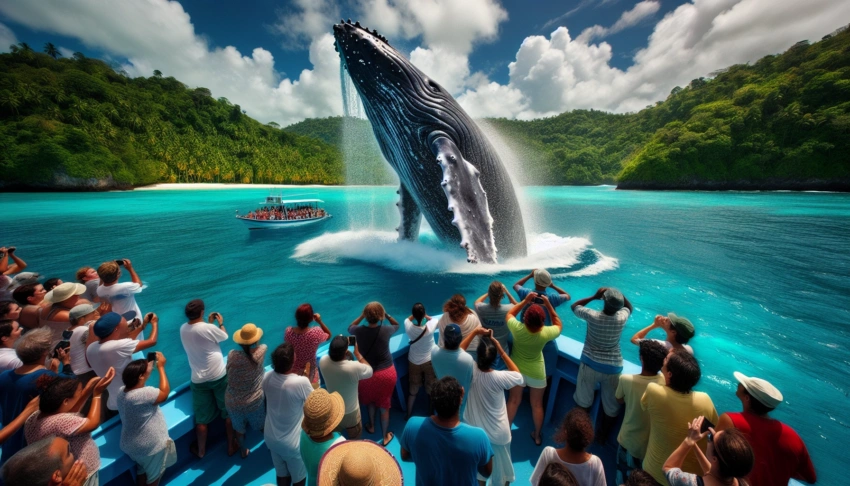
A Practical Guide to Responsible Whale Watching in Samaná Bay (Updated for 2025)
Welcome to Samaná Bay, a mesmerizing sanctuary where the giants of the sea come to play. Nestled in the northeastern corner of the Dominican Republic, this bay is a renowned hotspot for whale enthusiasts, offering an unparalleled glimpse into the lives of these majestic creatures.
1. Why Samaná Bay is a Whale-Watching Haven
Samaná Bay is not just a geographical location; it’s a whale-watcher’s paradise thanks to its unique environmental and geographical characteristics. The bay’s warm, shallow waters provide an ideal breeding and calving ground for humpback whales. These conditions are particularly favorable from January to March, when the whales migrate from the North Atlantic to enjoy the tropical climate.
One reason Samaná Bay stands out as a prime whale-watching destination is its protected status. The bay is part of the larger Marine Mammal Sanctuary of the Dominican Republic, which spans over 19,000 square miles. This sanctuary provides a safe haven for whales, ensuring minimal human interference and a flourishing environment for marine life.
2. History of Whale Watching in Samaná Bay
The history of whale watching in Samaná Bay is as rich as the waters themselves. It all began in the late 1980s when local fishermen noticed an increasing number of tourists interested in observing the whales. This burgeoning interest led to the establishment of organized tours, transforming Samaná into a bustling hub for eco-tourism.
As whale watching grew in popularity, so did the local economy. Today, it’s a vital component of Samaná’s tourism industry, attracting thousands of visitors each year. The impact has been overwhelmingly positive, creating jobs and fostering a deep appreciation for marine conservation among locals and tourists alike.
3. Whale Species in Samaná Bay
While Samaná Bay is home to a variety of marine life, the humpback whales are undoubtedly the stars of the show. Known for their acrobatic displays and hauntingly beautiful songs, these gentle giants captivate audiences with their playful breaches and tail slaps.
Humpback whales aren’t the only residents, though. Occasionally, visitors might spot other cetaceans such as dolphins or even pilot whales. However, it’s the humpbacks that steal the limelight, with their distinctive white pectoral fins and unforgettable songs that can travel for miles underwater.
Embarking on a whale-watching adventure in Samaná Bay is not just about seeing whales; it’s about diving into a world where nature’s magnificence is on full display. The bay’s unique attributes make it a must-visit destination for anyone passionate about marine life and conservation.
Understanding Whale Behavior
To truly appreciate the majestic presence of whales in Samaná Bay, understanding their behavior can transform your whale-watching experience from a mere sightseeing tour into an enriching adventure. Delving into the fascinating world of whale habits and interactions not only enhances your appreciation but also enriches the narrative of your journey.
1. Whale Migration Patterns
Whales are the undisputed masters of long-distance travel, embarking on epic migrations that defy imagination. In the case of the humpback whales frequenting Samaná Bay, their journey is a remarkable feat of nature. These giants travel thousands of miles from the cold feeding waters of the North Atlantic to the warm, welcoming embrace of the Caribbean. This migratory path is dictated by the need to breed and give birth in the safe, temperate waters of Samaná Bay, away from the icy predators of the north.
For whale watchers, timing is everything. The best chance to witness these majestic creatures is during the peak of their migration, from mid-January to late March. During these months, the bay becomes a bustling hub of activity, offering unparalleled opportunities to observe courtship displays, mothers nurturing their calves, and the occasional acrobatic breach. To maximize your experience, consider planning your visit around these months, when the likelihood of sightings is highest.
2. Social Structures of Whales
Whales are not solitary wanderers of the ocean; they are deeply social creatures with complex group dynamics. Humpback whales, in particular, exhibit fascinating social structures that are both intriguing and heartwarming. These magnificent mammals often travel in pods, which can range from small family groups to larger, temporary congregations during feeding or mating seasons.
Understanding the social behavior of whales adds a layer of depth to your observations. Look out for the tender interactions between mothers and calves, the synchronized swimming of courtship rituals, and the playful antics of young whales as they learn the ropes of ocean life. Each interaction tells a story of community, cooperation, and communication, offering a glimpse into the intricate lives of these ocean giants.
3. Communication Among Whales
Whale communication is a symphony of sounds that echoes through the ocean depths, creating a rich tapestry of interaction. The haunting songs of humpback whales are perhaps the most iconic, with their complex sequences of moans, cries, and howls that can travel vast distances underwater. These vocalizations serve multiple purposes, from attracting mates to establishing territory and even coordinating group activities.
While on your whale-watching adventure, keep your ears open for the melodic tunes of these oceanic troubadours. The experience of hearing a whale song reverberate through the water is nothing short of magical, a reminder of the unseen connections that bind these creatures together. By tuning into these natural symphonies, you gain a deeper appreciation of the whales’ world and the subtle intricacies of their interactions.
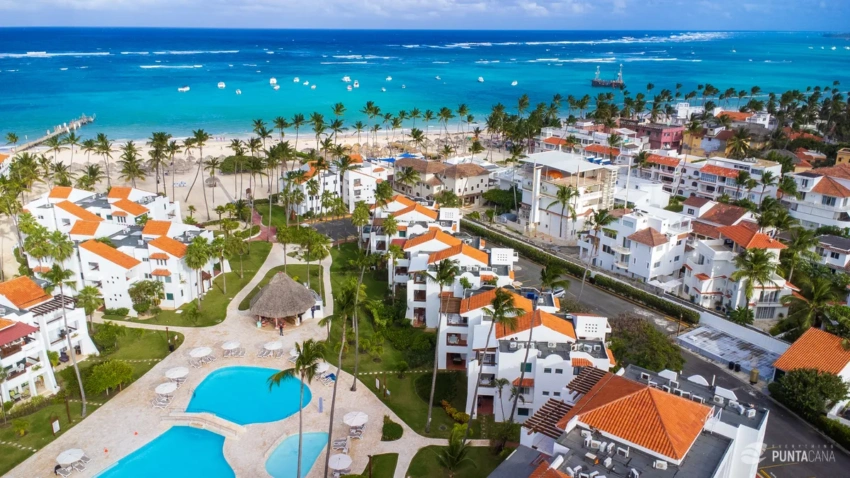
Punta Cana
The intricacies of whale behavior are a testament to the wonders of nature and the intelligence of these magnificent creatures. By understanding their migration patterns, social structures, and communication, you not only enrich your whale-watching experience but also develop a profound respect for these gentle giants of the ocean.
Planning Your Whale Watching Trip
Planning a whale-watching trip to Samaná Bay is an exciting adventure, but it’s essential to prepare responsibly to ensure a memorable experience while safeguarding the majestic whales.
1. Best Time to Visit Samaná Bay
The prime whale-watching season in Samaná Bay typically spans from mid-January to late March, coinciding with the annual migration of humpback whales. During this period, these magnificent creatures journey from the frigid North Atlantic waters to the warm and sheltered breeding grounds of Samaná Bay. The bay’s calm and nutrient-rich waters offer a perfect setting for mothers to nurture their calves and for males to engage in spectacular displays of breaching and tail-slapping.
For optimal sightings, consider planning your visit during the peak months of February and March. The early mornings and late afternoons are particularly rewarding, as the cooler temperatures and tranquil sea conditions provide ideal viewing opportunities. Keep in mind that whale activity is heavily influenced by environmental factors such as tides and weather, so staying flexible with your schedule can enhance your chances of witnessing these awe-inspiring mammals.
2. Choosing a Responsible Tour Operator
Selecting a responsible tour operator is crucial to ensuring that your whale-watching adventure is both enjoyable and ecologically sustainable. Look for operators that prioritize eco-friendly practices and adhere to guidelines set by marine conservation authorities. These operators typically have trained guides who are knowledgeable about whale behavior and committed to minimizing the impact on the whales and their habitat.
When evaluating tour operators, consider the following criteria:
- Compliance with Local Regulations: Ensure that the operator follows established guidelines for whale watching, including maintaining safe distances and limiting the number of boats in the vicinity of the whales.
- Educational Component: Choose operators that provide informative briefings about whale behavior, conservation efforts, and the importance of protecting marine ecosystems.
- Reputation and Reviews: Research reviews and testimonials from previous visitors to gauge the operator’s commitment to responsible tourism and customer satisfaction.
By selecting a responsible tour operator, you’re not only supporting sustainable tourism but also contributing to ongoing conservation efforts that protect these magnificent creatures for future generations.
Our Best Tours in Punta Cana
Looking to book a whale-watching tour in Samaná Bay? Explore our curated selection of tours that offer an unforgettable experience while prioritizing sustainability. Don’t miss this chance to witness the grandeur of humpback whales in their natural habitat.
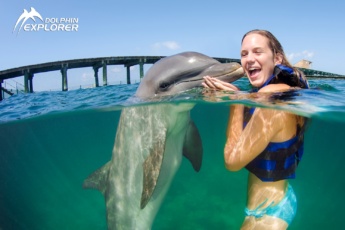
Swimming with Dolphins in Punta Cana - Top Adventure 2026 (50 minutes)
from $155 Read more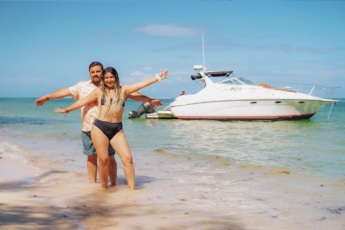
Punta Cana Private Boat Trip at the Best Price - 3-Hour Exclusive Tour with Snorkeling (from Jellyfish to Cabeza de Toro)
from $590 Read more3. What to Bring on Your Whale Watching Trip
To maximize your comfort and enjoyment during your whale-watching excursion, it’s important to pack thoughtfully. Here are some essential items to consider bringing along:
- Sunscreen and a Hat: Protect yourself from the sun’s rays, as you’ll be spending several hours on the open water.
- Binoculars: Enhance your viewing experience by bringing a pair of binoculars to get a closer look at the whales’ captivating behaviors.
- Camera: Capture the magical moments with a camera, but remember to be mindful of your surroundings and avoid using flash photography.
- Water and Snacks: Stay hydrated and energized throughout the trip with plenty of water and light snacks.
- Eco-Friendly Attire: Wear comfortable, weather-appropriate clothing and consider clothing made from sustainable materials to further reduce your ecological footprint.
By preparing carefully and respectfully, you’re poised to enjoy a breathtaking and responsible whale-watching experience in Samaná Bay that leaves both the environment and your spirit uplifted.
Responsible Whale Watching Practices
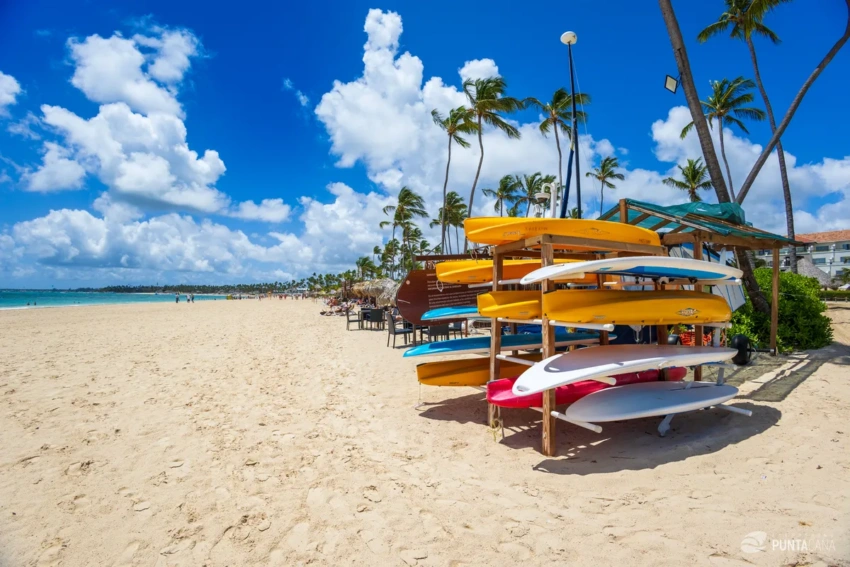
Punta Cana
Embarking on a whale-watching adventure in Samaná Bay is an unforgettable experience, but it’s crucial to approach it with care and consideration for the magnificent creatures and their habitat. By following responsible whale-watching practices, you can enjoy a thrilling encounter while ensuring the safety and preservation of whales.
1. Keeping a Safe Distance
Respecting the personal space of whales
is a critical aspect of responsible whale watching. Maintaining a safe distance not only protects the whales but also enhances your viewing experience. The National Oceanic and Atmospheric Administration (NOAA) recommends staying at least 100 yards away from whales. This distance prevents stress or disruption to their natural behaviors, such as feeding and nurturing their young.
It’s essential to remember that whales can be unpredictable. Keeping a safe distance allows them freedom of movement and reduces the risk of accidental collision. Binoculars can enhance your viewing experience without compromising the safety of these majestic creatures.
2. Minimizing Noise Pollution
The underwater world is a symphony of sounds, and for whales, these sounds are vital for communication, navigation, and locating food. Thus, minimizing noise pollution during whale-watching excursions is essential. Here are some practical tips to achieve this:
- Choose tour operators who use quieter engine technologies or sailboats, which produce less noise pollution.
- Encourage your boat captain to maintain a slow and steady speed to reduce engine noise and avoid sudden changes in speed or direction.
- Refrain from making loud noises or sudden movements on the boat, as these can disturb the whales and disrupt their natural behaviors.
By reducing noise pollution, you contribute to a more serene environment, allowing whales to thrive and communicate effectively.
3. Avoiding Physical Interaction with Whales
While it might be tempting to reach out and touch a whale, it’s crucial to understand that any physical interaction can be harmful to these creatures. Whales have sensitive skin, and human touch can introduce bacteria or disrupt the protective layer on their skin.
Observing whales from a distance not only respects their natural habitat but also ensures their safety and well-being. It allows you to witness their natural behaviors without interference, making the experience more authentic and rewarding.
Our Best Tours in Samaná Bay
Ready to embark on a responsible and awe-inspiring whale-watching journey? Discover our curated selection of tours that prioritize eco-friendly practices, ensuring a safe and memorable experience. Book now and join us in preserving the beauty of Samaná Bay for future generations.

Punta Cana Private Boat Trip at the Best Price - 3-Hour Exclusive Tour with Snorkeling (from Jellyfish to Cabeza de Toro)
from $590 Read more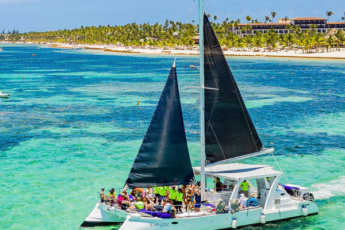
Power Cruise – Punta Cana Party Experience on the Bad Girl Catamaran
from $65 Read moreContributing to Whale Conservation
In the heart of Samaná Bay, where the majestic humpback whales grace us with their presence, lies an opportunity for visitors to make a meaningful impact. Contributing to whale conservation is not just about observing these magnificent creatures; it’s about ensuring their survival for generations to come.
1. Supporting Local Conservation Programs
Engaging with local conservation programs is a profound way to give back to the community and the whales. Samaná Bay is home to several dedicated organizations working tirelessly to protect marine life and habitats.
- CEBSE (Centro para la Conservación y Eco-desarrollo de la Bahía de Samaná y su Entorno): This local NGO focuses on the sustainable development of Samaná Bay. Visitors can support their initiatives by donating or volunteering for their educational and conservation projects.
- The Whale Samaná Foundation: Known for its conservation efforts, this foundation offers programs that visitors can partake in, including educational tours that fund whale protection efforts.
The provided information is for informational purposes only and may not be up-to-date. Please verify with official sources before using it.
2. Participating in Citizen Science
Citizen science offers a unique avenue for tourists to contribute to scientific research. By participating, you can help researchers gather valuable data on whale populations and behaviors.
- Whale Sighting Logs: Many conservation groups encourage visitors to log their whale sightings. This data helps track whale movements and population health.
- Photo Identification Projects: Tourists can contribute by taking photos of the whales, particularly their tails, which are unique to each whale, much like fingerprints in humans. These photos aid in identifying and tracking individual whales.
Engaging in these activities not only enhances your experience but also provides critical data that supports ongoing conservation research.
3. Promoting Awareness Through Social Media
In today’s digital age, social media is a powerful tool for spreading awareness and inspiring action. By sharing your responsible whale-watching experiences, you can raise awareness about the importance of conservation.
- Share Stories and Photos: Post your experiences and highlight the importance of conservation in your captions. Consider using hashtags like #WhaleConservation and #SustainableTourism to broaden the reach.
- Engage with Conservation Content: Follow and interact with organizations and activists dedicated to marine conservation. Sharing their content can amplify their messages and initiatives.
Remember, each post can inspire someone else to become a conservation advocate. Your voice matters, and when combined with others, it can lead to significant change.
Beyond Whale Watching: Exploring Samaná Bay
Samaná Bay is not just a paradise for whale enthusiasts; it offers a rich tapestry of culture, nature, and vibrant experiences. Let’s dive into what else this enchanting region has to offer beyond its famous waters.
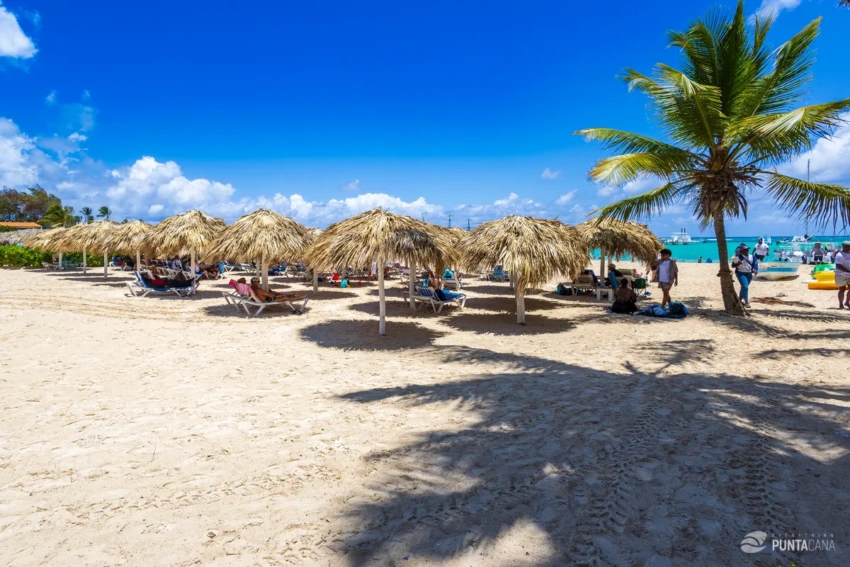
Punta Cana
1. Local Culture and Cuisine
Unveiling the local culture of Samaná is like opening a treasure chest filled with colorful traditions and tantalizing flavors. The region is steeped in history and vibrant cultural expressions that are worth exploring.
Samaná’s Culinary Riches
The culinary scene in Samaná is a delightful adventure for your taste buds. From the freshest seafood to traditional Dominican dishes, the flavors are as diverse as they are delicious. Don’t miss out on trying mangú (mashed plantains) and la bandera (rice, beans, and meat), which are local favorites. Visit El Timón de Samaná for a taste of the sea with a stunning view of the bay.
Exploring local markets, such as the Samaná Market, offers a glimpse into the daily life of the residents and a chance to sample exotic fruits and delicacies. It’s a lively experience that’s both educational and fun.
2. Exploring Samaná’s Natural Beauty
Samaná is a paradise for nature lovers, offering more than just its stunning bay. The peninsula is home to lush landscapes, diverse wildlife, and exciting outdoor activities.
Nature’s Playground: Activities and Attractions
One of the must-see attractions is the El Limón Waterfall. A short hike through the jungle will reward you with the sight of this majestic cascade. It’s a perfect spot for cooling off with a refreshing swim.
For bird enthusiasts, Los Haitises National Park is a biodiverse haven. The park’s mangroves, caves, and islets are perfect for spotting a variety of bird species, including the rare Ridgway’s Hawk. Kayaking through the park offers an intimate view of its stunning natural beauty.
3. Accommodation and Travel Tips
Choosing the right place to stay can enhance your Samaná experience, providing comfort and convenience as you explore the region.
Where to Stay in Samaná
The region offers a range of accommodations, from charming guesthouses to luxury resorts. For an eco-friendly stay, consider Eco Lodge El Valle, which offers a rustic experience amidst nature. If you prefer something more upscale, the Bahia Principe Luxury Cayo Levantado offers stunning views and top-notch amenities.
When planning your visit, consider renting a car for greater flexibility in exploring the peninsula. While public transportation is available, having your own vehicle allows you to discover hidden gems at your own pace.
Our Best Tours in Punta Cana
While you’re exploring the wonders of Samaná, why not seize the opportunity to book an unforgettable tour? We offer a range of thrilling excursions that showcase the best of Punta Cana and beyond. Whether you’re an adventure seeker or a culture lover, there’s something for everyone.
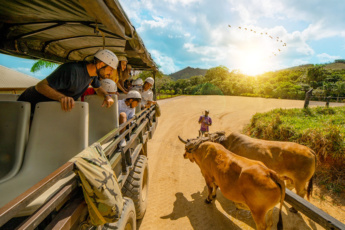
La Hacienda Park - 7-in-1 Adventures Tour in Bávaro, Punta Cana
from $99 Read more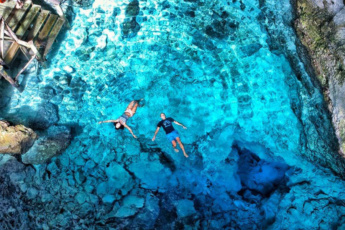
Scape Park in Punta Cana - Full Admission
from $129 Read moreWith so much to see and do, Samaná Bay truly is a destination that caters to all types of travelers. Whether you’re here for the whales or the myriad of other experiences, you’re sure to leave with memories that will last a lifetime.
Frequently Asked Questions
What is the best time of year to go whale watching in Samaná Bay?
The best time for whale watching in Samaná Bay is from mid-January to late March. During this period, humpback whales migrate to the warm waters of the Dominican Republic for mating and calving.
How can I ensure that my whale watching tour is eco-friendly and responsible?
To ensure your tour is eco-friendly, choose operators who adhere to local guidelines for responsible whale watching. Look for certifications or partnerships with conservation organizations. These operators should prioritize the well-being of the whales and minimize environmental impact.
Are there any regulations I should be aware of when whale watching in Samaná Bay?
Yes, there are specific regulations to protect the whales. Boats must keep a safe distance from the whales, limit the time spent near them, and adhere to speed restrictions. Always choose tours that follow these regulations.
Note: Regulations may change, so check for the latest guidelines before your trip.
What should I bring on a whale watching tour in Samaná Bay?
Bring sunscreen, a hat, sunglasses, and a camera with a good zoom lens. Also, consider wearing a light jacket as it can get windy on the water. Binoculars can enhance your viewing experience.
Can I see other marine life besides whales in Samaná Bay?
Yes, while humpback whales are the main attraction, you may also spot dolphins, sea turtles, and various bird species during your tour.
How long do whale watching tours typically last in Samaná Bay?
Most whale watching tours in Samaná Bay last between 2 to 4 hours, depending on the operator and the specific itinerary.
Is whale watching safe for children?
Yes, whale watching is generally safe for children. However, ensure that the tour operator provides safety equipment like life jackets for all passengers. It’s advisable to check with the tour provider about age restrictions or recommendations.
How can I help support whale conservation efforts in Samaná Bay?
You can support conservation by choosing responsible tour operators, spreading awareness about whale protection, and donating to organizations dedicated to marine conservation. Additionally, follow all guidelines during your tour to minimize your impact on the whales.
What should I do if I see a whale in distress during the tour?
Inform the tour guide immediately. Tour operators are trained to handle such situations and can contact relevant authorities for assistance.
Note: Do not attempt to intervene directly, as this can be dangerous for both you and the whale.
